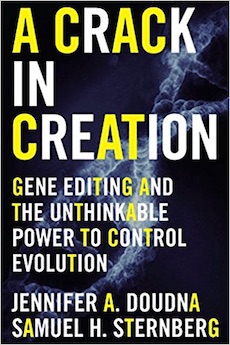Shortlisted for the 2018 Phi Beta Kappa Award in Science
By Louis J. Kern
An elegant account of the development of the immensely powerful genetic engineering tool (CRISPR) promising the potential for reversal of recessive genetic diseases like sickle-cell anemia and hyperargininemia and retro-viral ones like HIV. Jennifer A. Doudna, a pioneer in its discovery, and her co-author Samuel H. Sternberg, provide a fascinating account of the progression of molecular biology from the sequencing of the human genome to the emergence of effective gene therapy and gene editing.
The emergence of cutting edge genetic tools through research directed towards enhancing the immunological response of bacteria to viral infections is enthusiastically described in the first half of the book, while the second half considers their potential for the food supply and human health.
While the text offers some challenges to the reader, its scientific specifics are presented in a lively narrative aimed at the non-specialist. Doudna is especially conscious of the need for scientists to communicate with the general public because the issues raised by genetic engineering are transcendently important and when (not if) its use is expanded to human beings there must be the widest possible discussion of its physical, social, cultural, and moral consequences.
CRISPR, an inter-chromosomal, short sequence of DNA repeats capable of turning genes off and on and, in conjunction with Cas9 protein and tracer RNA, of targeting and cutting out discrete segments of DNA and replacing them with artificially generated DNA segments, makes possible total human control of the evolution of all terrestrial flora and fauna including that of homo sapiens—transgenic animals, de-extinction, and genetically engineered humans. This genetic technology augments the scope and power of contemporary embryonic scans and reproductive interpositions—amniocentesis, IVF, intracytoplasmic sperm injection, and cloning—facilitating the birth of children free of genetic defect and with greatly enhanced immune systems, CRISPR thus offers the potential for reversal and ultimate elimination of genetic diseases, the elimination of birth defects, and the enhancement of selected physical and mental traits of our posterity. It also presages the elimination of pathogens and insect pests that infect both our bodies and our food crops.
Given the promise of this bio-technology, it is not surprising that three companies were created between 2013 and 2015 for further research designed to provide an inexpensive and effective version—CRISPR II. Yet the potential for its misuse is troubling. While its medical use in human subjects as gene therapy and gene editing (using recombinant DNA) targets monogenic inherited conditions like cystic fibrosis and hemophilia, promising somatic emendation, its germline use on heritable traits is less benign. When coupled with embedded CRISPR, the inserted artificial DNA can spark genetic drive that has a cascading effect on the genome of an entire species. Effective in reducing insect populations, it could have disastrous effects if applied to humans.
As Doudna points out, as a therapeutic tool CRISPR has the same problem as pharmaceuticals—off-target effects that are difficult to predict. As gene therapy it raises the specter of eugenics and the prospect of reproductive inequality. Given the history of nuclear technology, she aptly observes that once a scientific discovery is made it cannot be unlearned. The ecological impact of the complete elimination of a viral vector, the de-extinction of the carrier pigeon or great auk, the revivification of the wooly mammoth, or the engineering of radically new species are unpredictable; perils of the Anthropocene made manifest. Doudna recommends legal restrictions and prohibition of some germline applications of CRISPR and immediate ethical and ecological consideration of other uses.
This is a compelling and important book that should be read by all who are concerned with the future of the earth and humanity.
Louis J. Kern (ΦBK, Clark University,1965) is professor emeritus of history at Hofstra University. Hofstra University is home to the Omega of New York chapter of Phi Beta Kappa.




